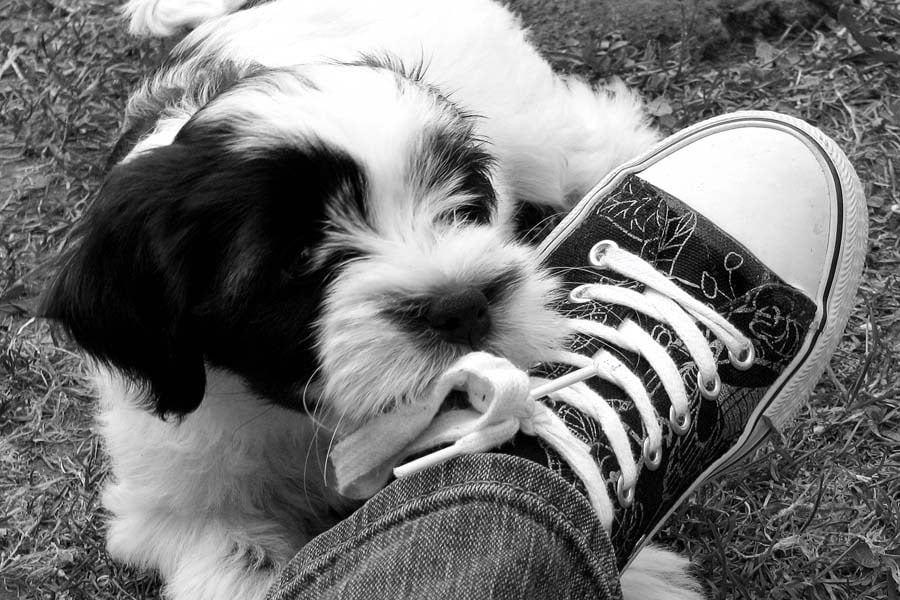A Turramurra Vet Article
Avoiding Dog Bites in Children

Avoiding Dog Bites in Children
by Dr Gretta Howard
Do you really know how to read dog behaviour?
Does a tail wag always mean a dog is happy?
Should growling be discouraged when a child is interacting with your dog?
Should dogs be hugged by children?
When a dog bites a child, the surrounding adults are often in shock as often the bite appeared to be ‘unprovoked’ and often that particular dog was familiar to the child had ‘never bitten anyone before’. Usually however, there are behavioural cues from the dog that can be identified well before the actual bite takes place but those signs are usually not recognised until it is too late.
ALL dogs have the capability of biting, even if there are no previous signs of aggression. Biting is a form of self-preservation and more common if a dog is placed in a fearful situation. While big dogs may produce a bigger bite, do not under estimate the power of a toy breed’s jaws, especially as the smaller dogs can sometimes feel overwhelmed by the actions of toddlers and bite in fear of their own life!
Spending some time learning about how to properly read a dog’s mood can prevent dog bites in the majority of cases. It is not as simple as looking at a dog’s tail wagging – this simply means he or she is willing to communicate, but not what that particular communication will be.
Learn to read ‘doggy body language’
Before and during any dog-child interaction, look for loose, relaxed body movement – I refer to this as a ‘floppy’ dog appearance – as though the whole dog is wagging, not just the tail. This is known as the green zone.
When a dog becomes unsure and uncomfortable in a situation, this is known as the orange zone. It is important to watch out for this body language as may be unsafe for a child to interact with a dog showing some of these signs:
- Lick licking
- Yawning
- Barking (can be a sign of anxiety)
- Ears positioned back against the head
- Stiffened body position (tail may still be wagging)
- Whites of the eyes become more obvious
- Lip lifting
- Growling
- Snapping
If a dog starts to show any of these signs we need to respect their feelings and give him or her some space.
The orange zone can quickly progress to the red zone, where the dog is highly aroused, fearful and can no longer think clearly. Signs include:
- Excessive barking
- Lunging
- Biting
- Freezing (with fear)
Red flags in puppy behaviour
If a puppy is consistently showing orange or red zone signs indicating anxiety, then it is a good idea to see your veterinarian for a behaviour assessment. Your vet will most likely recommend a referral to a veterinary behaviourist – one who has extra qualifications in veterinary behaviour – for a consultation. It is vital to act as quickly as possible as the sooner the problem is identified, the better the outcome.
Factors that contribute to an increased risk of behavioural abnormalities are listed below:
- Puppies hand-reared alone
- Puppies with anxious parents (genetic)
- Puppies separated from their mother’s before 6 weeks of age
- Puppies bred in an environment which lacks stimulation
Remember when acquiring a rescue dog, it is important to find out as much as possible about the dog’s history as possible, especially if you have young children as there may be safety concerns.
Is better training the solution to aggression?
The socialisation period for puppies is 3 to 12 weeks of age (sometimes up to 14 weeks). The ideal time to attend puppy socialisation classes is between 8-12 weeks old. If you wait until your puppy has been fully vaccinated (usually by 16 weeks) – this is too late! Find a class that takes them in younger (after the first puppy vaccination) when your puppy will benefit the most.
If you have a dog that has behavioural issues please organise a consultation with your vet rather than googling a solution on the internet – there are many outdated techniques online – some of which are aired on prime time television!
Behavioural issues are not always able to be solved through training alone, in fact, attempting to train a dog in an anxious state can be futile and may even make the situation worse. See your vet to determine whether your dog has a clinical behavioural problem (which needs veterinary help) or a problem behaviour which can be addressed by a trainer.
I would urge you to visit www.dogwelfarecampaign.org which discusses welfare in dog training before choosing a trainer. Trainers who have completed Delta Society modules and workshops and use positive training methods are my first preference.
Improving safety of children around dogs
Never allow children to be near a dog that is eating – it is normal for a dog to resource guard their food and putting a child between a dog and its food is a recipe for disaster.
Hugging is not understood by dogs and may frighten them. Do not encourage your child to hug the dog around the neck. This is heavily encroaching into their personal space and can increase anxiety and lead to biting behaviour. The child needs to learn to respect the dog’s space and approach the dog in a non-threatening and quiet manner, rather than with an unpredictable and overbearing greeting.
Always ask the dog’s owner if your child is allowed to pat their dog. Never play with a dog without their owner watching and never enter a dog’s yard without their owner present.
Be careful not to surprise a sleeping dog, particularly an older dog who may not hear and could become scared if woken suddenly by touch without warning.
Don’t allow children to play with a litter of puppies near the mother, especially if she is still feeding them as she may be very protective of her puppies and her instincts may be in full swing.
Ensure your children interact quietly and carefully with dogs and not get too overexcited or noisy.
Always respect a dog’s decision to move away and do not chase the dog.
Further resources to help protect your children from dog bites
Remember that 77% of dog bites come from the family dog or a friend’s dog – did you see it coming?
There is a wonderful YouTube video that all parents should watch and help their children to learn how to better interact with dogs in a safe manner. Visit www.stopthe77.com to watch this informative video.
An excellent resource for children with posters and video on their website is:
https://www.thefamilydog.com/stop-the-77/
Click on the preventing dog bites point and then download the factsheets and posters designed by Dr Sophia Yin – veterinary behaviourist.
If you are considering getting a puppy and you have children – I would highly recommend the following book:
“Perfect Puppy in 7 Days: How to start your puppy off right” by Dr Sophia Yin
Available from www.drsophiayin.com
If you are pregnant and are concerned about how your dog may react to your new baby – I would recommend reading the following book:
“Tell Your Dog You’re Pregnant” by Dr Lewis Kirkham
Available from www.babyandpet.com.au


